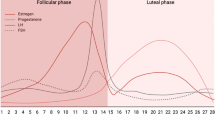Summary
The metabolic and hormonal responses to an intensive single-circuit weight-training session were studied in 15 untrained male students. The training programme consisted of ten exercises, employing all the large groups of muscles. Students performed three circuits using a work-to-rest ratio of 30 s:30 s at 70% of one-repetition maximum. The whole programme lasted 30 min. Blood samples were obtained from the anticubital vein 30 min before exercise, immediately after exercise finished and after 1-h, 6-h, and 24-h periods of recovery.
The training session produced significant increases in the plasma adrenocorticotropic hormone, cortisol, aldosterone, testosterone, progesterone and somatotropin concentrations. The plasma level of insulin and C-peptide remained unchanged. The strength exercises caused elevated ratios of cortisol:testosterone and cortisol:insulin, indicating a prevalence of stimulation of catabolic processes as well as of mobilization of energy reserves but during the recovery period the reverse of this was observed. Immediately after exercise the mean lactate concentration was 7.19 mmol · 1−1, SD 0.56, the glucose concentration increased significantly during exercise and decreased rapidly during recovery. The high density lipoprotein-cholesterol increased in 1-h period of recovery compared with the initial level. The concentration of total cholesterol, low density lipoprotein-cholesterol and triglyceride, did not change. Packed cell volume did not change during exercise or recovery.
Similar content being viewed by others
References
Berger GMB, Griffiths MP (1987) Acute effects of moderate exercise on plasma lipoprotein parameters. Int J Sports Med 8:336–341
Burstein M, Scholnick HR, Morfin R (1970) Rapid method for the isolation of lipoproteins from human serum by precipitation with polyanions. J Lipid Res 11:583–595
Collins MA, Hill DW, Cureton KJ, Demello JJ (1986) Plasma volume change during heavy-resistance weight lifting. Eur J Appl Physiol 55:44–48
Dufaux B, Assmann G, Hollmann W (1982) Plasma lipoproteins and physical activity. A review. Int J Sports Med 3:123–136
Enger SC, Stromme SB, Refsum HE (1980) High density lipoprotein cholesterol, total cholesterol and triglycerides in serum after a single exposure to prolonged heavy exercise. Scand J Clin Lab Invest 40:341–345
Friedewald WT, Levy RI, Fredrickson DS (1972) Estimation of the concentration of low-density lipoprotein-cholesterol in plasma, without the use of the preparative ultracentrifuge. Clin Chem 18:499–502
Gagnon J, De Carufel D, Brisson CR, Tremblay RR (1983) Influence of the training level on the dynamics of plasma androgens in resting and during exercise in the male dog. In: Knuttgen HG, Vogel JA, Poortmans J (eds) Biochemistry of exercise. Human Kinetics, Campaign, Ill, pp 645–651
Goldberg RB, Rabin D, Alexander AN, Doelle GC, Getz GS (1985) Suppression of plasma testosterone leads to increase in serum total and high density lipoprotein cholesterol and apoproteins A–I and B. J Clin Endocrinol Metab 60:203–207
Grimby G, Björntorp P, Fahlen M, Hoskins TA, Höök O, Oxhöj H, Saltin B (1973) Metabolic effects of isometric training. Scand J Clin Lab Invest 31:301–305
Guezennec Y, Leger L, Lhoste F, Aymonod M, Pesquies PC (1986) Hormone and metabolite response to weight-lifting training sessions. Int J Sports Med 7:100–105
Häkkinen K, Pakarinen A, Alen M, Kauhanen H, Komi PV (1988) Neuromuscular and hormonal responses in elite athletes to two successive strength training sessions in one day. Eur J Appl Physiol 57:133–139
van Helder WP, Radomski MW, Goode RC (1984) Growth hormone responses during intermittent weight lifting exercise in man. Eur J Appl Physiol 53:31–34
van Helder WP, Radomsky MW, Goode RI, Carey K (1985) Hormonal and metabolic response to three types of exercise of equal duration and external work output. Eur J Appl Physiol 54:337–342
Hettinger T (1961) Physiology of strength. Thomas, Springfield Jaffe BM, Behrman HR (eds) 1979 Methods of hormone radioimmunoassay. Academic Press, New York
Keul J, Haralambie G, Bruder M, Gottstein HJ (1978) The effect of weight lifting exercise on heart rate and metabolism in experienced weight lifters. Med Sci Sports 10:13–15
Knowlton RG, Hotzler RK, Kaminsky LA, Morrison JJ (1987) Plasma volume changes and cardiovascular responses associated with weight lifting. Med Sci Sports Exerc 19:464–468
Kraemer WJ, Noble BJ, Clark MJ, Culver BW (1987) Physiologic responses to heavy-resistance exercise with very short rest periods. Int J Sports Med 8:247–252
Kraemer WJ, Marchitelli L, Dziados J, Mello B, McCurrey D, Harman EA, Frykman PN, Damokosh A, Cruthiros C, Fleck SJ (1988) Hormonal and growth factor responses in males and females to heavy resistance exercise. Can J Sport Sci 13:22P
Rogozkin VA (1979) Metabolic effects of anabolic steroids on skeletal muscle. Med Sci Sports 11:160–163
Stone MH, Pierce K, Godsen R, Wilson GD, Blessing D, Rozenek R, Chromiak J (1987) Heart rate and lactate levels during weight-training exercise in trained and untrained men. Phys Sport Med 15:97–105
Sutton JR, Coleman MJ, Casey JH (1978) Testosterone production rate during exercise. In: Landry F, Orban WAR (eds) 3rd International Symposium on the Biochemistry of Exercise. Symposia Specialists, Miami, p 227–234
Tesch P, Colliander EB, Kaiser P (1986) Muscle metabolism during intense, heavy-resistance exercise. Eur J Appl Physiol 55:326–366
Viru A (1984) The mechanism of training effects: a hypothesis. Int J Sports Med 5:219–227
Viru A, Karelson K, Smirnova T, Port K (1990) Activity of pituitary-adrenocortical system during various exercises. In: Nazar K, Terjung RL, Kaciuba-Uścilko M, Budohsu L (eds) International Perspectives in Exercise Physiology. Human Kinetic Books, Champaign, pp 160–165
Weiss LW, Cureton KJ, Thompson FN (1983) Comparison of serum testosterone and androstanedione responses to weight lifting in men and women. Eur J Appl Physiol 50:413–419
Wilkinson JE, Horvath SM, Gutin B (1980) Plasma testosterone during treadmill exercise. J Appl Physiol 49:249–253
Author information
Authors and Affiliations
Rights and permissions
About this article
Cite this article
Jürimäe, T., Karelson, K., Smirnova, T. et al. The effect of a single-circuit weight-training session on the blood biochemistry of untrained university students. Europ. J. Appl. Physiol. 61, 344–348 (1990). https://doi.org/10.1007/BF00236051
Accepted:
Issue Date:
DOI: https://doi.org/10.1007/BF00236051




